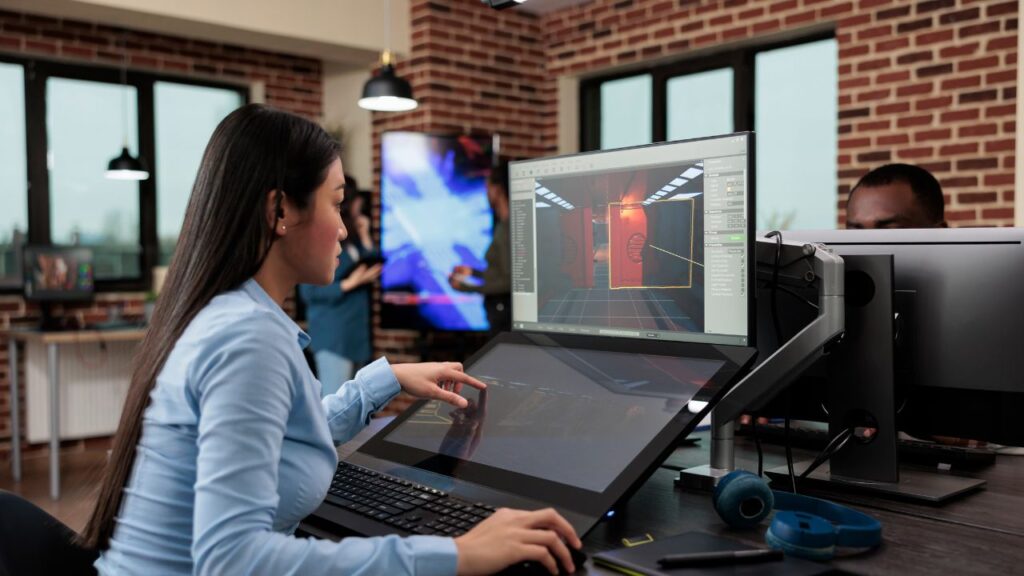Creating levels for platformer games can feel overwhelming when you stare at a blank screen. Many game developers struggle with where to place platforms, how to balance difficulty, and what makes players want to keep playing. The difference between a boring level and an exciting one often comes down to understanding a few key design principles.
Good platformer level design guides players naturally through challenges while teaching them new skills step by step. The best levels feel like a conversation between the designer and player. They introduce ideas, let players practice, then test what they learned in fun ways.
This guide covers the core principles that make platformer levels work well. You’ll learn practical strategies for creating engaging gameplay flow and discover techniques that keep players interested from start to finish. Whether you’re making your first game or improving your skills, these methods will help you build levels that players actually enjoy completing.
Why Do These Core Principles Matter for Great Platform Games?
Good platformer levels need three main things to work well: smooth player movement, fair difficulty, and clear visual guides. These basics help players enjoy the game without getting stuck or confused.
How Does Player Movement Shape Your Level Design?
Understanding how players move is the most important part of making platformer levels. Every jump, run, and dash creates rules that designers must follow.
Jump distance sets how far apart platforms can be. If a character can jump 5 units, gaps should never be bigger than 4 units without special help. This keeps players from getting stuck.
Movement speed affects how much time players have to react. Fast characters need more warning before dangers appear. Slow characters can handle tighter spaces and quicker reactions.
Special abilities like double jumps or wall climbing change everything. Designers must place platforms and obstacles to use these skills. A wall jump area needs the right wall height and spacing.
Players learn movement through practice. Early levels should teach basic jumps. Later levels can mix different movement types together. Each new area should build on what players already know.
Air control lets players adjust jumps after they start. High air control means more forgiveness. Low air control means more precision. Both styles work but need different level layouts.
What Makes Challenge Fair Instead of Frustrating?
Good platformers balance difficulty so players feel challenged but not angry. This balance comes from smart design choices about timing, spacing, and player feedback.
Difficulty curves should go up slowly. Easy sections let players practice new skills. Hard sections test what they learned. Players need time to get better before facing bigger challenges.
Failure feedback helps players understand mistakes. Deaths should feel like learning moments, not random punishment. Clear cause and effect relationships show players what went wrong.
Multiple paths give players choices. Easy routes help new players finish levels. Hard routes reward skilled players with secrets or faster times. Both players feel good about their choice.
Checkpoint placement reduces frustration. Good checkpoints sit before hard sections, not after easy ones. Players should never repeat boring parts after failing exciting challenges.
Telegraph dangers by showing them early. Spikes should look sharp. Moving platforms should have clear patterns. Players need time to see and plan for obstacles.
Why Does Visual Clarity Make or Break Your Game?
Clear visuals help players understand what they can do and where they can go. Poor visual design confuses players and breaks the game flow.
Platform recognition must be instant. Solid ground should look different from backgrounds. Foreground elements need strong outlines or bright colors. Players should never guess what they can stand on.
Danger identification keeps players safe. Harmful objects need consistent visual language. All spikes might be red, all fire might be orange. Players learn these rules and trust them.
Interactive elements should stand out from decoration. Buttons, switches, and pickups need clear visual markers. Animation or special effects can draw attention to important items.
Depth separation helps in complex scenes. Background elements should be darker or blurred. Foreground gameplay elements should be bright and sharp. This creates clear visual layers.
Color coding organizes information quickly. Blue might mean safe, red might mean danger, green might mean collectible. Consistent color use helps players make fast decisions.
Lighting direction guides player attention. Bright areas draw the eye forward. Dark areas hide secrets or show paths already taken. Light creates natural movement flow through levels.
What Makes Players Keep Coming Back to Your Platformer?
Good level design needs smart difficulty curves that teach players without frustrating them. The best platformers create memorable worlds filled with hidden treasures that reward curious players.
How Do You Build Difficulty That Feels Just Right?
Progressive difficulty means each level teaches something new while using skills from earlier stages. Players should feel challenged but never overwhelmed.
Start with simple obstacles in the first few levels. A single enemy or basic jump teaches core mechanics. Each new challenge should build on what players already know.
Layer complexity gradually by combining familiar elements. If players learned to jump over enemies in level one, level three might add moving platforms. Level five could combine both with a time limit.
Use safe spaces where players can practice new skills. Put difficult sections after checkpoints so players can retry without losing progress. This keeps frustration low while maintaining challenge.
Test your levels with different skill levels. Watch where players struggle or get stuck. Good difficulty feels natural, not forced.
What Creates Environments Players Want to Explore?
Engaging environments tell stories through visual design and layout. Every screen should feel purposeful and interesting to navigate.
Vary the visual themes between areas. Forest levels might have organic, curved platforms while factory levels use sharp, geometric shapes. This variety keeps players interested.
Create multiple paths through levels when possible. Some players like to rush through the main route. Others prefer to explore every corner. Both approaches should feel rewarding.
Use visual cues to guide players naturally. Bright colors draw attention to important areas. Darker areas suggest danger or secrets. Players should understand where to go without obvious arrows.
Environmental storytelling adds depth without words. Broken bridges hint at past events. Scattered coins suggest other adventurers passed through. These details make worlds feel alive.
Why Should You Hide Secrets Throughout Your Levels?
Secrets and rewards give players reasons to replay levels and explore carefully. They transform linear paths into treasure hunts.
Power-ups work well as hidden rewards. Extra lives, temporary abilities, or health boosts motivate players to search thoroughly. Place these rewards behind breakable walls or in hard-to-reach spots.
Collectibles like coins or gems encourage thorough exploration. Some players ignore the main path completely to find every hidden item. This extends playtime naturally.
Bonus areas reward skilled players with special challenges. A difficult jump sequence might lead to a room full of treasures. These areas should feel optional but worthwhile.
Visual hints help players spot secrets without making them obvious. A crack in a wall might hide a passage. A slightly different colored platform could be breakable. Good secrets feel discoverable, not random.



